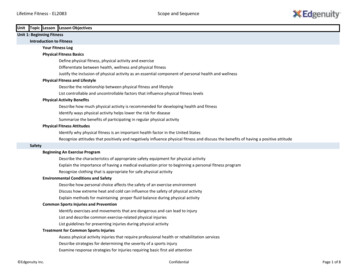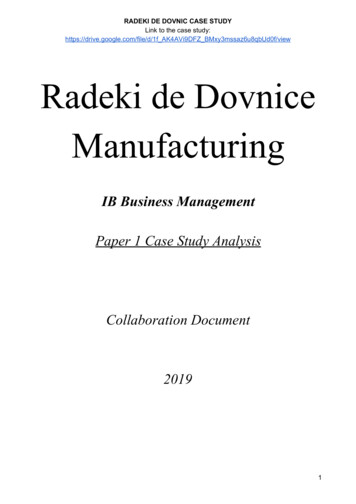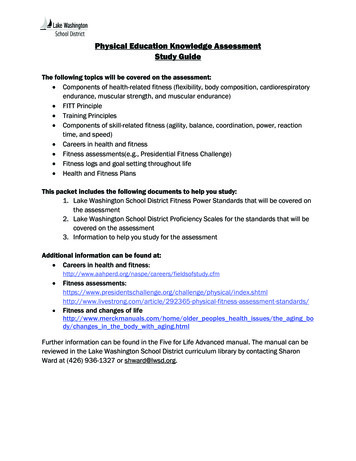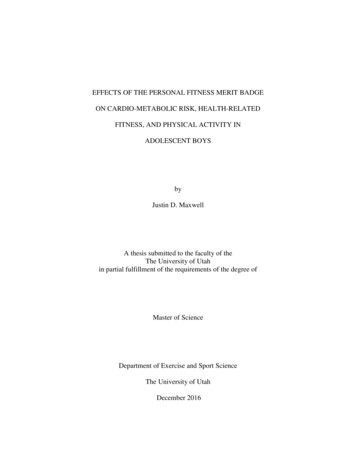
Transcription
TABLE OF CONTENTSIntroduction. 1Hormones . 2The Feedback Loop . 3How Hormones Interact . 4PMS And PMDD. 8Thyroid Health .10Diet For Thyroid Health .11Exercise For Thyroid Health.11Body Fat .13Belly Fat .14Ideal Body Fat .15Measuring Body Fat .15Cellulite .17Risk Factors.17Treatment Options.18Osteoporosis .21Symptoms .21Risk Factors.22Diagnosis.23Treatment Options.23Menopause .24
Perimenopause .24Menopause .25Treatment Options.26Alternative Therapies.27Heart Disease .28Statistics In Women .28Symptoms .29Prevention .30Treatment Options.30Breast Cancer .31Symptoms .31Risk Factors.32Types .35Treatment Options.35Lifestyle Diseases .36What Is A Lifestyle Disease .36Causes Of Death Over Time.39Diet And Exercise .40Stress.41The Stress Response .41Symptoms And Effects of Stress.42Recognizing Stress.43
De-Stressing Your Life .44Managing Stress .44Fatigue .46Top Causes Of Fatigue .46How To Increase Energy .48Nutrition .50What Is Good Nutrition?.50Healthy Foods For Women .51Complex Versus Simple Carbs .53Good Fats .53Depression .54Signs .54Types Of Depression .55Biological Causes .55Psychological Causes .56Depression Management .57What You Can Do .57Autoimmune Diseases .59Statistics On Women With Autoimmune Disease .59Diagnosis Of Autoimmune Diseases .60Treatment Options.61Conclusion .62
Disclaimer: This publication is for informational purposes only and is not intended as medicaladvice. Medical advice should always be obtained from a qualified medical professional for anyhealth conditions or symptoms associated with them. Every possible effort was made to provideaccurate and current information.
INTRODUCTIONWhile men and women have many of the same health problems, they can affect womendifferently. For example, women are more likely to dieafter a heart attack than men are. Women suffergreater rates of depression and osteoarthritis affectsmore women than men.A woman’s body is different than a man’s in more waysthan the obvious and so they have special needs thatdrive reasons to gain awareness, and take action inprevention in the hope of reducing risk factors forvarious conditions.Too often in this ultra hectic modern world, womentend to neglect self-care until it’s too late. Today,women work, and take care of a household andchildren, which often leaves little time for them.Taking the time to become aware of common healththreats, and lifestyle choices that can improve healthand wellbeing is not only recommended, it is necessaryto ensure good health even into old age."If you think taking care of yourself is selfish, change your mind.If you don't, you're simply ducking your responsibilities." Ann Richards1 Page
HORMONESSurprisingly, men and women have the same hormones inside their bodies—just in differentamounts. While the hormonal milieu of men stays about the same over time, women have widefluctuations in their reproductive hormones according to their menstrual cycle. Postmenopausalwomen return to a state where the hormones fluctuate little, if at all.As children, women have ovaries that are relatively nonfunctional. They make very little estrogenand progesterone and almost no testosterone. When puberty happens, the cycle of femalehormones begins and the levels of estrogen, progesterone, follicle stimulating hormone, andluteinizing hormone fluctuate with the menstrual cycle.The Cycle1. The pituitary gland secretes FSH (follicle stimulating hormone) and LH (luteinizing hormone)in response to signaling from the hypothalamus in the brain.2. The LH and FSH levels peak atovulation, causing an egg to bereleased from among several partiallydeveloping eggs in the ovaries. This LHpeak is what is measured on homeovulation test strips.3. When the ovary releases an egg, thecyst in which the egg was createdbegins to make progesterone and thislevel is elevated for about two weeks.4. If the egg isn’t fertilized, the estrogen and progesterone level falls off and the progesteronelevel remains low until the next ovulation has occurred. Estrogen fluctuates less but is alsomade in the ovaries and helps to develop the growing egg.2 Page
Three Kinds of EstrogenThree kinds of estrogen are produced in the female body: Estradiol - main estrogen produced by menstruating womenEstriol - type of estrogen commonly seen in pregnancy although it is made in smallamounts at other timesEstrone - type of estrogen produced by postmenopausal womenWomen’s ovaries (and adrenal glands) make testosterone, too, but in lesser amounts than isseen in males. It is the testosterone in the female system that is responsible for the female sexdrive and is why the female sex drive isn’t as strong as it is in men.THE FEEDBACK LOOPThe hormones of the female body are involved in a careful feedback loop that relies on thefunctioning of the ovaries, the hypothalamus, and the pituitary gland. If any of these are off, thecycle gets out of control and the normal pattern of ovulation does not occur.During the first half of the menstrual cycle, the estradiol in a woman’s system causes the eggs tomature and is why the uterine lining thickens during that time. It is all in preparation for thepossibility of a fertilized egg to have a place to rest after ovulation. Because the estrogen level isup, a feedback loop keeps the LH and FSH low.At the time of ovulation, the pituitary gland releases a burst of LH and FSH in order to allow therelease of the egg. Progesterone levels keep the egg supported until it can be fertilized andbegins to make its own progesterone. The window of opportunity for fertilization is actually fairlynarrow, just a couple of days. The progesterone blocks the LH, which goes back down and theprogesterone begins to change the uterine lining in further preparation for the possibility of afertilized egg implanting in the uterus.If the egg is fertilized, the levels of progesterone and estrogen remain high to support theuterine lining and the zygote (tiny embryo) to implant in the uterine lining. The implanted zygotemakes HCG, which supports the entire system throughout the pregnancy. HCG (human chorionicgonadotropin) is the “pregnancy hormone” that is detected in home pregnancy tests.If the egg is not fertilized, the progesterone and estrogen levels plummet, causing the uterinelining to escape the body during the menstrual period.3 Page
It is all a very complex system that must rely on activity of several endocrine glands in order towork properly. A woman has only so many eggs in her lifetime, and when they “run out,” awoman goes through menopause and the ovary puts out much less estrogen, progesterone andtestosterone, so that the postmenopausal woman’s sex drive diminishes and she no longer hasstimulation of the uterine lining. This is when periods stop.After menopause, the hormone levels do not fluctuate and the FSH levels and LH levels from thepituitary gland are not released in a cyclical fashion any more.HOW HORMONES INTERACTMany women wonder why, when one thing goes wrong, such as when they have a low thyroidcondition, it affects things like the reproductive system, weight, and energy levels - all at thesame time. This is because our endocrine system is tightly interconnected, with feedback loopsand multiple uses for some hormones so that it takes the entire functioning system to feelbetter.The Pituitary Gland: The Master GlandThe pituitary gland is a tiny gland about the size of a small marble, located at the bottom of thehypothalamus in the brain. The hypothalamus strongly affects the pituitary gland, making adirect connection with hormones that cause the pituitary gland to function. Without thepituitary gland, attached to the hypothalamus by a slender stalk, many endocrine functions donot work. You’ll see in a minute why this is the case.4 Page
The hypothalamus is located just above the brain stem. It takes in stimuli from the entireperipheral nervous system and helps regulate our blood pressure, temperature, hormone,water, and nutrient concentration. Sometimes the hypothalamus acts on its own but it’s mostimportant function in the endocrine system is to make and release hormones that act directly onthe pituitary gland, which is called the “Master Gland” because of all of the functions it does.The pituitary gland is made of two lobes: the anterior lobe and the posterior lobe. The anteriorpituitary gland makes the bulk of the hormones, which in turn causes peripheral glands of thebody to release or hold back on the making of still other hormones.The hypothalamus and pituitary gland, along with the peripheral glands of the body, act inside afeedback loop so that when enough hormones are in the body, the pituitary gland shuts down soas not to stimulate the peripheral glands until hormone levels drop again.This is all tightly regulated so you need every gland to work properly for the feedback loops towork.The hypothalamus secretes both inhibiting hormones and releasing hormones, which aredelivered to the pituitary gland through tiny blood vessels located along the stalk that connectsthe two structures. The pituitary gland then releases various tropic hormones that causeperipheral glands to take action.The two hormones released by the pituitary gland are antidiuretic hormone (ADH) and oxytocin. Antidiuretic hormone is the hormone that regulates fluid and electrolyte balance in thebody.Oxytocin is the hormone that causes uterine contractions during labor. It also helps withmilk secretion during lactation.Hormones Released By The HypothalamusThe hormones released by the hypothalamus help the pituitary gland function. Abnormalities ofthe hypothalamus can severely affect the function of all glands of the body: Growth hormone releasing hormone causes the release of growth hormone from theanterior pituitary gland. Somatostatin causes the inhibition of growth hormone release from the anterior pituitarygland. Thyrotropin releasing hormone stimulates the release of TSH from the anterior pituitarygland, which in turn causes the thyroid gland to release its own hormones, T3 and T4.5 Page
Gonadotropin releasing hormone causes the anterior pituitary gland to release LH andFSH, which are reproductive hormones acting on both the male and female gonads.Prolactin releasing hormone causes the anterior pituitary gland to release prolactinduring lactation.Dopamine inhibits the release of prolactin by the pituitary gland.Corticotropin releasing hormone causes the anterior pituitary gland to release ACTH,which then causes the adrenal gland to release cortisol.In the anterior pituitary gland, there is the release of thyroid stimulating hormone commonlyreferred to as TSH, which stimulates the thyroid gland, ACTH, which stimulates cortisol releasefrom the adrenal gland, luteinizing hormone or LH, which causes ovulation and increasestestosterone levels, and follicle stimulating hormone or FSH that induces the production of eggsand sperm, depending on whether you are female or male.As mentioned, the anterior pituitary gland also secretes prolactin and growth hormone, whichstimulate milk production and growth, respectively.The Peripheral GlandsThe peripheral glands are where all the action is. This is where the hormones are released thatact directly on the cells of the body. For example, when the TSH in the pituitary gland is released,it triggers the release of thyroxine (T4) and triiodothyronine (T3) from the thyroid gland, whichregulate the metabolism of all the cells of the body.The thyroid gland also releases calcitonin, which regulates the amount of calcium andphosphorus in the body. If the T4 and T3 are too low, it sends a feedback signal to release moreTSH from the pituitary gland to try and further stimulate the thyroid gland.The parathyroid glands, located deep within the thyroid gland, causes the release of parathyroidhormone (PTH), which increases the calcium content in the body.Stress HormonesThe adrenal glands are also very important. They are located on top of each kidney and releasecortisol (stress hormone), which increase glucose levels and cause changes in the body related tostress.6 Page
They also release aldosterone, which regulate sodium and fluid balance in the kidneys. Deepwithin the adrenal glands, the adrenal medulla secretes epinephrine and norepinephrine, whichare important hormones in the body’s “fight or flight” response, occurring under stress.They increase heart rate, blood pressure, and respiratory rate, shunting blood from the core ofthe body to peripheral muscles where they can better “fight” or “flee” from perceived danger.Other HormonesThe male and female gonads produce the hormones that make us have male and femalecharacteristics. For example, the ovaries release estrogen and progesterone, which prepares thebirth canal during childbirth.The ovaries also release inhibin, which turns off the FSH production in the pituitary gland.Estrogen and progesterone act on the uterine wall to stimulate and mature the uterine lining. Inmales, the testicles produce testosterone, which increases libido, aids in sperm production, andgive men the traditional male characteristics. The testes also release inhibin, which turns off FSHproduction in males.The pancreas is also partly an endocrine gland, releasing glucagon to raise blood sugar andinsulin to lower blood sugar. It also releases somatostatin and pancreatic polypeptide, which acton growth hormone and regulate the release of insulin and glucagon.The pineal gland is located within the skull. It releases melatonin in response to the absence orpresence of light and helps us feel sleepy when it gets dark out and is time to go to bed.The kidneys also release hormones. For example, erythropoietin stimulates the formation ofmore red blood cells from the bone marrow. It also releases calcitriol, which acts on the smallintestines to increase the serum calcium absorption.How It All Fits TogetherThe various glands and hormones are all interconnected. If, for example, the ovaries don’t work,it triggers FSH and LH from the pituitary gland, which tries to further stimulate ovarianproduction of hormones. In women, the levels of all the reproductive hormones and reproductive-related pituitaryhormones fluctuate with the menstrual cycle and are responsible for the maturation ofthe uterine lining, the egg, and for the presence of the menstrual period if an egg is notfertilized.7 Page
During menopause, the ovaries cease production of estrogen, progesterone, andtestosterone (the actual amounts are not zero but are very low when compared to thechildbearing years) and there is no cyclical variation in the levels of the varioushormones.Many of the hormones have feedback loops to make sure that the hormone levels stay at the rightlevels. If the pituitary gland fails, many other bodily functions fail as well.On the other hand, if one of the peripheral glands fails, only those functions of the gland areinhibited.Overactive peripheral glands or an overactive pituitary gland can create a host of symptoms,depending on which glands and hormone levels are affected.PMS AND PMDDThe LH hormone surge occurs during ovulation as the egg is released and the ovary creates alarge amount of estrogen and progesterone in the last half of the menstrual cycle is when manywomen experience hormonal changes consistent with premenstrual syndrome.It is possible for any woman to develop mood changes during the last half of the cycle but someexperience mood changes so significantthat it interferes with daily life, and thismay mean a condition known asPremenstrual Dysphoric Disorder orPMDD.PMDD Symptoms: Severe mood swings that canchange by the day or hourSadness, loneliness, andhopelessnessIncreased angerAnxietyLoss of interest in hobbies and regular activitiesIrritabilityProblems with concentrationSleepiness or fatigue during the day8 Page
An increase or decrease in appetiteInsomniaFeeling out of control or overwhelmed by life’s challengesBreast tenderness, bloating, headaches, joint pain, and muscle painThese symptoms can interfere with daily functioning and affect a woman’s relationships both atwork and at home.Vitamins, a healthy diet, and regular exercise can help. If the symptoms are severe, a doctor maysuggest other effective treatments that can include oral contraceptives or even prescriptionmedication.9 Page
THYROID HEALTHWomen have a greater risk for low thyroid conditions when compared to men. This is partlybecause they have a higher incidence of autoimmune diseases such as Hashimoto thyroiditis anda higher incidence of Grave’s disease.Women who have low thyroid conditions, also called hypothyroidism, often suffer from obesity,constipation, fatigue, dry skin and a low metabolism. This is because we need the hormones(thyroxine and triiodothyronine) made by the thyroid gland in order to boost cellular metabolismin all cells of the body.Women especially should see their doctor and have their thyroid hormones checked periodically,including the level of thyroid stimulating hormone or TSH, which is the hormone produced bythe pituitary gland whenever the levels of thyroid hormone are too low. A high level of TSH isactually a better measurement of a low thyroid condition than are the measurements of thyroidhormones, T3 and T4.10 P a g e
DIET FOR THYROID HEALTHWomen need a healthy thyroid gland to maintain an elevated metabolism and to keep theweight down. Foods, which help keep the thyroid healthy, include the following: Fish: Fish are high in omega 3 fatty acids, particularly fatty fish like trout, wild salmon,sardines, and tuna. Omega 3 fatty acids decrease levels of inflammation, improve theimmunity, and help increase the levels of selenium, important for thyroid function. Whole grains: Whole grains help reduce the symptoms of constipation in women who havehypothyroidism. Unfortunately, it binds to exogenous sources of thyroid hormone (thyroidsupplements) and can lessen their effectiveness. Take your thyroid supplements on anempty stomach or whenever you are not eating whole grains. Nuts: Nuts contain a great deal of selenium, which help the thyroid gland work better.Because nuts are high in fat and calories, they should be eaten in moderation. Fresh vegetables and fruits: These great low calorie foods keep you from gaining weight ifyour thyroid function is lower than normal. Eat those fruits and vegetables highest in iodine.A diet low in iodine can contribute to goiter and low thyroid function. Seaweed: Seaweed contains a lot of iodine, a necessary part of thyroid function. Iodine isessential for the making of T4 and T3 in the thyroid gland. If you don’t have access toseaweed or don’t like it, get your iodine through the taking of iodized salt. Iodized salt hasdecreased the incidence of iodine-related goiter since it was introduced to the public. Toomuch iodine, however, can make thyroid disease worse. Dairy products: Dairy products are high in vitamin D. Low levels of vitamin D appear toincrease the risk of Hashimoto’s thyroiditis, which is the most common type ofhypothyroidism. Beans: You can put beans in many types of recipes. There are many healthful vitamins andminerals in beans that are needed by the cells for improved cellular metabolism. Beans alsoadd fiber to the diet, which helps keep blood sugars and cholesterol under control. Youshould consume between 20 and 35 grams of fiber daily for good thyroid health.EXERCISE FOR THYROID HEALTHYou should also boost your metabolism, counteracting the effects of hypothyroidism, throughdaily exercise. It is best to mix aerobic and anaerobic exercise in order to build muscle and burncalories. Exercise can increase the metabolism for several hours after exercise. If the thyroidlevel is low, you may not have the strength or stamina for much exercise but whatever you can11 P a g e
do in terms of low impact aerobics and lifting weights (or using weight machines) will help yoursluggish thyroid do its best.Fortunately, synthetic thyroid supplements of T4 and T3 are available so you don’t have to sufferfrom the negative effects of low thyroid on your body. Taking the supplements will lower yourTSH level, indicating that you are taking the right dose of thyroid supplement. If you are onthyroid supplements, your doctor will measure your TSH level periodically and at least once peryear even if you don’t have any symptoms of low or high thyroid conditions.12 P a g e
BODY FATWomen naturally have more body fat than men do. It has to do with the female hormonal milieuand the evolutionary need to have excess body fat for pregnancy and lactation energy sources.Even if you work out with weights and other types of exercises, your body fat measurements willlower but your weight may not move at all. This is because body fat is less dense and takes upmore space by volume than muscle tissue. When you exercise to build muscle, you take up lessspace but weigh the same, because muscle weighs more than fat.Your MeasurementsIn measuring your fitness level, it helps to know what your body mass index is. BMI charts areavailable online, and the formula is bodyweight divided by height (in inches) squared andmultiplied by 703. Any BMI less than 25 is normal BMI between 25 and 29 means you are overweight BMI of 30 or greater means you are obeseThe problem with weight measurements and the calculation of the BMI is that these measures donot indicate how much body fat you actually have.An active woman with an increased percentage of muscle when compared to fat may see ahigher rating on the BMI scale simply because muscle weighs more than fat. In the same way, anormal BMI doesn’t mean you don’t have too much body fat.13 P a g e
BELLY FATBelly fat is especially concerning for a woman’s health.Metabolic SyndromeWomen who have extra body fat in the mid- toupper abdominal area have an increased risk of
feedback loop so that when enough hormones are in the body, the pituitary gland shuts down so as not to stimulate the peripheral glands until hormone levels drop again. . (ADH) and oxytocin. Antidiuretic hormone is the hormone that regulates fluid and electrolyte balance in the











